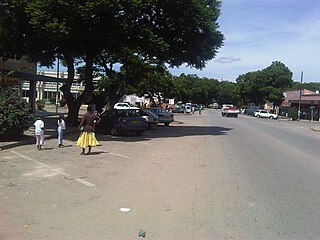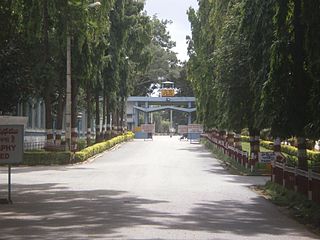
Harare, formerly Salisbury, is the capital and largest city of Zimbabwe. The city proper has an area of 982.3 km2 (379.3 sq mi), a population of 1,849,600 as of the 2022 census and an estimated 2,487,209 people in its metropolitan province. The city is situated in north-eastern Zimbabwe in the country's Mashonaland region. Harare is a metropolitan province which also incorporates the municipalities of Chitungwiza and Epworth. The city sits on a plateau at an elevation of 1,483 metres above sea level, and its climate falls into the subtropical highland category.

Manicaland is a province in eastern Zimbabwe. After Harare Province, it is the country's second-most populous province, with a population of 2.037 million, as of the 2022 census. Making it the third most densely populated province after Harare and Bulawayo provinces. Manicaland was one of five original provinces established in Southern Rhodesia in the early colonial period. The province endowed with country's major tourist attractions, the likes of Mutarazi Falls, Nyanga National Park and Zimbabwe's top three highest peaks. The province is divided into ten administrative subdivisions of seven rural districts and three towns/councils, including the provincial capital, Mutare. The name Manicaland is derived from one of the province's largest ethnic groups, the Manyika, who originate from the area north of the Manicaland province and as well as western Mozambique, who speak a distinct language called ChiManyika in Shona.

Mutare, formerly known as Umtali until 1982, is the capital and largest city in the province of Manicaland. It is the third most populated in Zimbabwe. Having surpassed Gweru in the 2012 census, with an urban population of 224,802 and approximately 260,567 in the surrounding districts, Mutare adds to the wider metropolitan area a total population of over 500,000 people. Mutare is also the capital of Manicaland Province and the largest city in eastern Zimbabwe.

Boronia is a suburb in Melbourne, Victoria, Australia, 29 km east of Melbourne's Central Business District, located within the City of Knox local government area. Boronia recorded a population of 23,607 at the 2021 census.

Rusape is a town in eastern Zimbabwe.
Dobsonville is a township in greater Soweto, Johannesburg, South Africa. It lies to the west of Meadowlands, a part of Diepmeadow, and is adjacent to Mofolo North and Zondi, which are suburbs of Soweto on its southern border.
Highfield is the second oldest high-density suburb or township in Harare, Zimbabwe built to house Rhodesians of African origin, the first being Mbare. Highfield was founded on what used to be Highfields Farm. It is of historical, cultural and political significance to Zimbabwe and is known as Fiyo in local slang. It is one of the birthplaces of the Zimbabwe African National Union and is home to several prominent people in the country such as Gregy Vambe and Oliver Mtukudzi, and formerly Robert Mugabe.
Chegutu, originally known as Hartley, is a town in Mashonaland West Province, Zimbabwe.

Beitbridge is a border town in the province of Matabeleland South, Zimbabwe. The name also refers to the border post and bridge spanning the Limpopo River, which forms the political border between South Africa and Zimbabwe. The border on the South African side of the river is also named Beitbridge.

Baud is a commune in the Morbihan département in Brittany in northwestern France.

Buhera District is a district in Manicaland Province, in eastern Zimbabwe.
Hauna is a village in the province of Manicaland, Zimbabwe located in the Honde Valley communal land about 55 km north of Mutare.It is the Growth Point Centre for Mutasa District in Manicaland. Hauna growth point is in Samanga B ward of Mutasa District and has a population of about 8,000. There is an aerodrome where small aeroplanes can land and take off. There is also a Police camp called Ruda Police Station which controls all police activities in Mutasa District.
Nyazura is the second largest urban settlement in Makoni District in Manicaland Province, Zimbabwe located 72 km north-west of Mutare on the main road and railway linking Harare and Mutare. The settlement is named after the Nyazure River which is a tributary of the Save River. The phosphate from Dorowa are handled by the railways here. The town is located 191km from Harare along the Harare Mutare Highway. It is 20 kilometres from Rusape and 70km from Mutare. The major part of Nyazura is believed to be under the rule of the Rukweza family.
Chatsworth is a small settlement in the Masvingo Province of Zimbabwe. It is located about 58 km north of Masvingo on the Masvingo-Gweru railway line. The settlement started in 1911 as a railway station. It administered under the Gutu Rural District Council.
Avondale is a residential suburb in north and northwest Harare, Zimbabwe, located about 3.5 kilometres (2 mi) north of Harare city centre and just west of Mount Pleasant. It is the earliest suburb established in Harare, having been laid out in 1903. Prior to becoming a suburb Avondale was a dairy farm and was named after Avondale, County Wicklow, Ireland the home of the 19th-century Irish politician Charles Stewart Parnell. Avondale was incorporated into Harare Municipality in 1934.

Mbare, originally known as Harari, is a suburb in the south of Harare, Zimbabwe. Founded in 1907 as a township, it includes an informal settlement. Mbare Musika is the largest farm produce market in Zimbabwe.

Eaglehawk is a suburb within the City of Greater Bendigo and a former gold-mining town in Victoria, Australia.
Mutasa District is one of seven districts in Manicaland Province of Zimbabwe. Mutasa District is located 30 km northeast of Mutare and stretches up to the Honde Valley, which is about 100 km northeast of Mutare along a tarred road that branches off the Nyanga road.

Borrowdale is a residential suburb in the north of Harare, Zimbabwe, which ranks among the most affluent and prestigious residential areas in the country. It forms part of the Northeast suburbs of the city of Harare, with a population of 28,929 as of the Zimbabwe 2022 Census.

BHEL Township, Hyderabad is a suburb of Hyderabad, Telangana. This has been developed like other BHEL townships after Indian public sector engineering company BHEL started its operations here. Township is well known for its greenery and lush green campus and large numbers of quarters with full amenities. Hostels for ET's, Assistant Engineers and artisans are available here. It is spread over an area of around 16 km2 and provides facilities like, parks, community halls, sports complex, grounds, library, shopping centers, banks, and post offices. Free health services are extended to all the employees and their dependents through BHEL run hospital.













